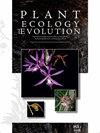南湾(南极洲利文斯顿岛)底栖硅藻的多样性和栖息地偏好
IF 1.1
4区 生物学
Q3 PLANT SCIENCES
引用次数: 6
摘要
背景和目的-尽管有悠久的研究历史,南极海洋底栖硅藻的知识是零碎的。本研究报道了利文斯顿岛南湾的海洋底栖硅藻,重点研究了生活在坚硬基质上的硅藻,以及不同海岸生境的种类分布。材料和方法-样本收集自潮汐池(19)、潮间带鹅卵石(9)、安装在不同深度的人工基质(10)、海岸岩石(2)和深度为bbb20 m的底部沉积物(2)。物种鉴定和群落分析使用LM进行,并使用SEM获得附加信息。采用基于硅藻丰度数据的nMDS分析了不同生境/基质类型和采样月份样品间的差异。利用PERMANOVA软件对生境/基质类型和采样月份对硅藻群落的影响进行了检验。利用SIMPER分析了类群内部和类群之间的相似性/差异性。主要结果-总共记录了133个硅藻分类群,其中110个为底栖生物。大量的分类群不能确定。给出了一些分类和命名史复杂的罕见物种的分类注释和生态分布资料。提出了一种新的组合方法。硅藻群落受生境/基质类型的影响,而不受季节的影响。潮池群落与鹅卵石、人工基质和沉积物上的群落,以及沉积物和人工基质上的群落存在显著差异。在鹅卵石上和通常在人工基材上占主导地位的双翅片。形成粘液管、树形菌落和嵌入粘液的细胞链的物种仅限于潮汐池。结论:南湾底栖硅藻群落高度多样化,物种在沿海生境中分布明显,但研究较少,分类群的命名史往往令人困惑,使其鉴定具有挑战性,并且该地区潜在的常见物种仍然未知。本文章由计算机程序翻译,如有差异,请以英文原文为准。
Diversity and habitat preferences of benthic diatoms from South Bay (Livingston Island, Antarctica)
Background and aims – Despite a long research history, knowledge of Antarctic marine benthic diatoms is fragmentary. This study reports on marine benthic diatoms from South Bay, Livingston Island, focusing on diatoms living on hard substrata, and species distribution across different coastal habitats.Material and methods – Samples were collected from tidal pools (19), intertidal cobbles (9), artificial substrata installed at various depths (10), coastal rocks (2), and bottom sediments at depths > 20 m (2). Species identifications and community analyses were done using LM with additional information obtained using SEM. nMDS based on diatom abundance data was applied to display differences between the samples by habitat/substratum type and sampling month. The significance of the habitat/substratum type and sampling month on diatom communities was checked with PERMANOVA. Similarity/dissimilarity within and between sample groups and their contributing species were explored with SIMPER.Key results – In total, 133 diatom taxa were recorded, of which 110 are benthic. A large number of taxa could not be certainly identified. Taxonomic remarks and ecology and distribution data for some rarely reported species with convoluted taxonomic and nomenclatural histories are given. One new combination is proposed. Diatom communities were influenced by the habitat/substratum type, but not by seasonality. Significant differences existed between communities in tidal pools and those on cobbles, artificial substrata, and sediments, and between those on sediments and artificial substrata. Navicula aff. perminuta dominated on cobbles and often on artificial substrata. Species forming mucilage tubes, tree-like colonies, and chains of cells embedded in mucilage were restricted to tidal pools.Conclusion – Benthic diatom communities from South Bay are highly diverse and species show distinct distributions in the coastal habitats, but the scarce studies and often confusing nomenclature history of the taxa make their identification challenging, and potentially common species for the region remain unknown.
求助全文
通过发布文献求助,成功后即可免费获取论文全文。
去求助
来源期刊

Plant Ecology and Evolution
PLANT SCIENCES-
CiteScore
2.20
自引率
9.10%
发文量
27
审稿时长
>12 weeks
期刊介绍:
Plant Ecology and Evolution is an international peer-reviewed journal devoted to ecology, phylogenetics and systematics of all ‘plant’ groups in the traditional sense (including algae, cyanobacteria, fungi, myxomycetes), also covering related fields.
The journal is published by Meise Botanic Garden and the Royal Botanical Society of Belgium.
 求助内容:
求助内容: 应助结果提醒方式:
应助结果提醒方式:


